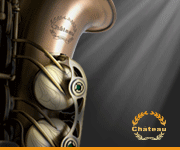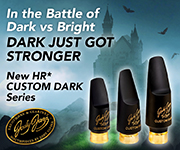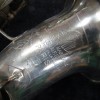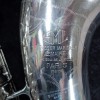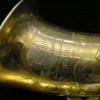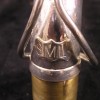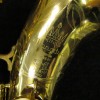 Forgot Username? Forgot Password?
Forgot Username? Forgot Password?
 SML
SML
Strasser Marigaux & Lemaire was founded on Jan 12, 1935 by three partners: Charles Strasser, a businessman who was born in Switzerland; Jules-Appolin Marigaux, an instrument maker who trained at Buffet-Crampon, where his father was "premier ouvrier," and Lemaire. The company grew quickly. SML acquired the French Besson Company in the late 1930's and purchased the esteemed Louis Lot Company circa 1951. After the death of Lemaire in 1950, Strasser and Marigaux bought their partner's shares and the company became known as "Strasser-Marigaux." Marigaux died about 1970, leaving Strasser the sole owner of the company. Circa 1974 Strasser sold SML to a holding company -- Strasser-Marigaux S.A. and Yves Rilba was elected as the first president of SML. In 1975 SML bought the Malerne Musical Instrument Company which was located across the street in LaCouture, just outside Paris. LaCouture is known as being a meca of woodwind craftspeople. They moved all of their production into this new larger factory of ~600 square meters. Along with the acqusition came a woman named Madame Herivaux (niece of Mr. Malerne). She became foreman of the SML factory in 1977. By 1982 SML employed 30 factory workers in LaCouture and about 20-25 people in Paris (final testers and adjusters, sales staff, and company executives). A few SML workers also practiced their trade at home in their own shops.
Since its earliest days, SML has been known for its oboes. Marigaux was considered one of the two best oboe-makers in France, on par with Lorée. As growth came quickly, the company rapidly broadened its line of woodwinds to included saxophones, flutes and bassoons.
SML began making saxophones within a few years of its being founded -- at about the same time Selmer introduced its revolutionary Balanced Action saxophone. SML ceased production of saxes in 1982; at the time, the company was making ~400 saxes a year (2500 total musical instruments including over 900 oboes). It was also exporting saxes to King Musical Instruments, which marketed them under the name,"King Marigaux." A company spokesperson said SML stopped making saxophones because "we just couldn't compete with Selmer anymore."
SML made sopranos, altos, tenors and baritones in gold plate, silver plate, nickle plate and gold lacquer. The altos and tenors came in three models each: "Standard," "Gold Medal" and "Gold Medal 2-Tone." The baritones came in only the "Gold Medal."
The Standard is not described as a student or intermediate model, but it was clearly SML's non-pro model. It came in a "Perma-Gold" lacquer finish.
The Gold Medal, which also came with a lacquer finish, was promoted as the "ultimate" in saxophones with "22 outstanding mechanical features not found on American or European saxophones. Used exclusively by top American and European symphony and dance-band artists."
The two-tone model was a Gold Medal with nickel-plate keys and guards.
adapted from: 1. SML: Most Of The Story By FRED CICETTI (originally published on this site in 1997) 2.Interview with Yves Rilba By Nora Post 3. Research By Peter Hales
For your amusement, here are the list prices (not including cases): Standard alto, $350; Gold Medal alto, $415; Gold Medal 2-Tone alto, $435; Standard tenor, $400; Gold Medal tenor, $475; Gold Medal 2-Tone, $495; Gold Medal Baritone, $625.
The 22 mechanical features SML boasted about were:
1. Removable neck lock. A 4-slot ring exerts an even pressure on neck without leakage.
2. Improved octave key features a bearing-type, rocker-arm mechanism for faster action. Facilitates wide jumps and assures a full-bodied middle D, especially on tenor.
3. All screws are made of first-grade tool steel. Pivot screws are hardened to blue grade for long life.
4. All key mechanisms are hand forged.
5. Individual screw adjustments permit perfect key alignment.
6. Properly cupped pearl buttons are scientifically located to encourage flying fingers.
7. Ribs of key cups (tone hole covers) reinforce entire cup diameter.
8. D, D# and F keys are mounted on a single plate for security of posts in fastest passages.
9. Main actions are anchored to a single plate for greater strength.
10. Optional articulation feature with adjustable G# lock permits both group and individual execution of G# to C#, B-Bb. Makes entire action easier!
11. Side and main action rods are hand-ground ("swedged") for precision fit.
12. Set-screw adjustment for G# key.
13. Extra large (6¬") bell (tenor only) affords unusual carrying power and clear, pure pianissimo.
14. Set screw permits a better adjustment on lever that operates Bb key.
15. Clothes guard on back of instrument eliminates possibility of catching clothes under keys.
16. Entire bell, from opening to bow, is exquisitely hand-engraved.
17. Removable key guards allow easy access to low pads.
18. Low B and Bb handle smoothly because of special SML jam-proof rollers.
19. Drawn tone holes with precision-rolled thin-gauge edges allow maximum air passage without leakage or cutting of pads.
20. Adjustable bumper felt pads to permit tuning adjustments on low B, Bb, C and Eb.
21. Brilliantly hand-burnished from bell to neck. Protectively coated with a flawless lacquer finish applied by the exclusive Multi-Coat Process.
22. Precise intonation in the entire range!
My personal experience and comments I've gotten from knowledgeable saxophone players indicate that SML saxophones are among the best ever made.
Are they as good as Selmers, the industry standard?
Allow me this observation: Selmer, Buffet and SML are three great woodwind makers in France. Professional musicians choose Selmer for saxophones, Buffet for clarinets and SML for oboes. I believe the quality of the instruments made by the three companies is in all their products, not just one.
QUOTES
"To my knowledge, nothing has been written on SML in the Saxophone Journal. I've compiled wisps of information on the company over the years, but nothing more substantial than the internet banter of the last few months. I have tried a few SMLs, and I agree - they are fine instruments."
-Paul Cohen
"I have seen only about 20 of these fine (SML) horns in my life, and every one played well. Some were very exceptional. I have known of a couple of fine condition altos going for $1200 - $1500. For a gold-plated tenor in absolutely pristine condition with a fresh overhaul, I gave over 2K with a smile! It has the best voice of all of the tenors in my collection."
-Steve Goodson
"I have played about six SML saxes. And the ones that have been properly set up and maintained played wonderfully. It is a mystery to me why they were--or are--not more popular in this country or Europe. About the most famous SML player I have ever known is Carmen Leggio, who played tenor for Woody Herman."
-Brian Axelrod, USA Horn
"I have an SML King Marigaux tenor and I find it usually better than a Selmer SA80. And very solid too! Once, in an elevator, a fall of a meter resulted only in a small dent."
-Giovanni Terzi
"Do these things have a roaring giant sound or what? I love 'em."
-Morgan Witthoft (Owner of an SML alto, tenor and bari)
"I just got back from my big band rehearsal. The guy who plays there with an older Selmer tenor noticed the sound of my SML immediately."
-Harri "Sax on the Web" Rautiainen
"SML was a pretty serious company comprised of workers who left the Selmer factory perhaps a bit pissed at not being paid enough for their craft. They did make some great horns, and if you can find them in good shape they are as good or better than some of the finest Selmers ever made. They really perfected the combining of the best of both Conn and Selmer into one horn with some of their own innovations that Selmer was too set in it's own ideology to try."
"I bought my King Marigaux new in 1980. But it did take the dealer about six months to get one. All in all, it's a good semi-pro horn, but I'd trade it for a Mk VI or Mk VII in a heartbeat."
-Ross Klippert
"I've had a King Marigaux alto and thought it was a fine quality horn patterned after an SBA. I especially like the articulated G# lever."
-Gayle Fredenburgh
"I used to own an SML alto. They were made by three french companies Strasser, Marigaux and Le Maire. They were known for their fine tone and were definitely a conservatory level instrument. Later on, King distributed them under the Marigaux name. That's all I know."
-Mel Martin
"SML was a revolutionary concept in saxophone design that sought to replace the confusing Eb/Bb and Soprano/Alto/Tenor saxophone terminology with a much easier to understand Small/Medium/Large taxonomy. Under their system, Eb alto became small, Bb tenor became medium, and Eb bari became large. Their original marketing scheme was intended to expand into other sizes - petite (soprano), XL (bass), and XXL (contra bass) but the concept proved to be too far ahead of its time and the company eventually folded."
-B.B. Bean
"SML were French-made and, by all accounts, pretty good instruments. Some of them are frighteningly powerful, too. Much more so than anything being made these days! Sound, well-made instruments. Perhaps a little awkward to the modern hand which is used to the conveniences of Yamahas, etc."
-Michael Wells
"I have owned and played several of these (SMLs) and loved them all! When it comes to value, they are considered "sleeper" horns, sought after by people in the know. I think the people who like them are pretty zealous about them. But, alas, the Selmer mystique is a hard dragon to slay, even for an excellent company like SML."
-Jason DuMars
"When I play your horn, I sound like Paul Desmond."
-Phil Chester, my teacher
[less]Strasser Marigaux & Lemaire was founded on Jan 12, 1935 by three partners: Charles Strasser, a businessman who was born in Switzerland; Jules-Appolin Marigaux, an instrument maker who trained at Buffet-Crampon, where his father was "premier ouvrier... [more]
 SML Models
SML Models
 SML Serial Numbers
SML Serial Numbers
Year Range
Serial Range
| Rev. A | |
|---|---|
| 1935 - 1936 | 1 - 649 |
| 1936 - 1937 | 650 - 1299 |
| 1937 - 1938 | 1300 - 1949 |
| 1938 - 1939 | 1950 - 2599 |
| 1939 - 1940 | 2600 - 3249 |
| 1940 - 1941 | 3250 - 3899 |
| 1941 - 1942 | 3900 - 4499 |
| Rev. B | |
|---|---|
| 1942 - 1943 | 4500 - 5199 |
| 1943 - 1944 | 5200 - 5399 |
| 1944 - 1945 | 5400 - 5499 |
| 1945 - 1946 | 5500 - 5999 |
| Coleman Hawkins Model | |
|---|---|
| 1940 - 1941 | 3250 - 3899 |
| 1941 - 1942 | 3900 - 4499 |
| 1942 - 1943 | 4500 - 5199 |
| 1943 - 1944 | 5200 - 5399 |
| 1944 - 1945 | 5400 - 5499 |
| 1945 - 1946 | 5500 - 5999 |
| Super Model | |
|---|---|
| 1942 - 1943 | 4500 - 5199 |
| 1943 - 1944 | 5200 - 5399 |
| 1944 - 1945 | 5400 - 5499 |
| 1945 - 1946 | 5500 - 5999 |
| 1946 - 1947 | 6000 - 6699 |
| 1947 - 1948 | 6700 - 6999 |
| 1948 - 1949 | 7000 - 7300 |
| Rev. C | |
|---|---|
| 1949 - 1950 | 7300 - 7999 |
| 1950 - 1951 | 8000 - 8299 |
| Rev. D | |
|---|---|
| 1951 - 1952 | 8300 - 9599 |
| 1952 - 1953 | 9600 - 10399 |
| 1953 - 1954 | 10400 - 11199 |
| 1954 - 1955 | 11200 - 11999 |
| 1955 - 1956 | 12000 - 14999 |
| Gold Medal Mk. I | |
|---|---|
| 1956 - 1957 | 15000 - 15499 |
| 1957 - 1958 | 15500 - 15999 |
| 1958 - 1959 | 16000 - 16399 |
| 1959 - 1960 | 16400 - 16799 |
| 1960 - 1961 | 16800 - 16999 |
| 1961 - 1962 | 17000 - 17649 |
| 1962 - 1963 | 17650 - 18299 |
| 1963 - 1964 | 18300 - 18949 |
| 1964 - 1965 | 18950 - 18999 |
| 1965 - 1966 | 19000 - 19499 |
| 1966 - 1967 | 19500 - 19999 |
| 1967 - 1968 | 20000 - 20199 |
| Gold Medal Mk. II | |
|---|---|
| 1968 - 1969 | 20200 - 20999 |
| 1969 - 1970 | 21000 - 21499 |
| 1970 - 1971 | 21500 - 22299 |
| 1971 - 1972 | 22300 - 22699 |
| 1972 - 1973 | 22700 - 23099 |
| 1973 - 1974 | 23100 - 23499 |
| 1974 - 1975 | 23500 - 24599 |
| 1975 - 1976 | 24600 - 24799 |
| 1976 - 1977 | 24800 - 25299 |
| 1977 - 1978 | 25300 - 25599 |
| 1978 - 1979 | 25600 - 25999 |
| 1979 - 1980 | 26000 - 26299 |
| 1980 - 1981 | 26300 - 26599 |
| 1981 - 1982 | 26600 - 27000 |
| King Marigaux | |
|---|---|
| 1969 - 1970 | 21000 - 21499 |
| 1970 - 1971 | 21500 - 22299 |
| 1971 - 1972 | 22300 - 22699 |
| 1972 - 1973 | 22700 - 23099 |
| 1973 - 1974 | 23100 - 23499 |
| 1974 - 1975 | 23500 - 24599 |
| 1975 - 1976 | 24600 - 24799 |
| 1976 - 1977 | 24800 - 25299 |
| 1977 - 1978 | 25300 - 25599 |
| 1978 - 1979 | 25600 - 25999 |
| 1979 - 1980 | 26000 - 26299 |
| 1980 - 1981 | 26300 - 26599 |

